|
Related
FAQs: Red Algae 1, Red Algae 2, Red Algae 3, Red
Algae Identification, Red Algae ID
2, Red Algae ID 3, Red Algae ID 4, Red
Algae ID5, & Red Algae
Behavior, Red Algae
Compatibility, Red Algae
Selection, Red Algae Systems,
Red Algae Nutrition, Red Algae Disease, Red Algae Reproduction/Propagation,
Coralline
Algae, Coralline Algae
2, Coralline Algae
Identification, Coralline Algae
Behavior, Coralline Algae
Compatibility/Control, Coralline
Algae Selection, Coralline Algae
Systems, Coralline Algae
Nutrition, Coralline Algae
Disease, Coralline Algae
Reproduction/Propagation, Marine
Algae ID 1, Marine Algae ID 2,
Marine Algae Control FAQs II,
Marine Algaecide Use, Nutrient Limitation, Marine Algae Eaters, Culturing Macro-Algae; Controlling: BGA/Cyano, Red/Encrusting Algae, Green Algae, Brown/Diatom
Algae,
FAQs by Genus: Gracilaria/Ogo,
Related Articles: Marine Macro-Algae, Coralline Marine Algae,
Avoiding Algae Problems
in Marine System, Algae Control, Marine Maintenance,
Marine Scavengers, Snails, Hermit
Crabs, Mithrax/Emerald
Green Crabs, Sea Urchins, Blennies, Algae
Filters, Ctenochaetus/Bristle Mouth
Tangs, Zebrasoma/Sailfin Tangs,
Skimmers, Skimmer Selection, Marine Algae, Coralline
Algae, Green Algae, Brown Algae, Blue-Green
"Algae"/(Cyanobacteria), Diatoms, Brown
Algae,
/A Diversity of Aquatic
Life
The Red Algae, Division Rhodophyta, part 1
To:
part 2, part 3,
part 4
|
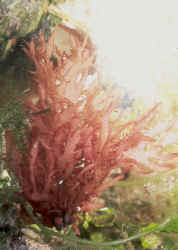
|
|
By Bob Fenner
|
Fauchea
sp.
|
 |
New Print and
eBook on Amazon
Marine Aquarium Algae Control
by Robert (Bob) Fenner
|
At long last the red algae, particularly the coralline
and encrusting calcareous forms, are receiving their due. These small,
unassuming forms play a huge role in the real development of coral
reefs, natural and aquarium; growing quickly, utilizing nutrients,
packaging them into food-useful formats while generating oxygen... all
under lower illumination than most co-photosynthetic animals or
Caulerpas.
Though we often refer to coral in labeling tropical
reefs, it is the algae, in particular the encrusting and branching reds
that make up a good deal of the biomass and productivity of these
important areas. Some estimates put the calcareous red algae at more
than half of both; providing resistance to wave action, providing
habitat and food for other living things.
Here we'll discuss what these "simple
plants" are, their recruitment, control and culture.
Classification: Taxonomy, Relation With Other Groups
Talk about misidentified life-forms! Rarely are these
organisms made out for what they are; algae. The larger red algae are
kelp-like, with leaf-like fronds, attaching holdfasts et al.; the
encrusting and branched varieties require closer inspection.
The simplest oxygen-producing life on this planet are the algae.
They are for the most part autotrophic (self-feeding), have no complex
organization (no leaves, roots, xylem/phloem vascular network); but do
contain chlorophyll and other photosynthetic pigments.
The various Divisions (equivalent
to the zoological taxonomic Phylum) of algae
are classes on several criteria; pigments (by which we may generally
identify them), storage foods, make-up of their cell walls and flagella
where present.
Most aquarists are more interested in avoiding algae than
knowing them better. Some algae are noxious, others indeed strange; all
are worthwhile at least in terms of identification and control.
A Classification of Algae
Kingdom Monera (No nuclear membrane, "naked"
DNA)
Division Cyanophyta- the blue green algae
Kingdom Protista (Beginning of eukaryotes)
Division Euglenophyta- Euglenoids
Division Pyrrophyta- Dinoflagellates
Division Chrysophyta- golden brown algae
Division Bacillariophyta- diatoms
Division Xanthophyta- yellow green algae
Division Phaeophyta- brown algae
Division Rhodophyta- red algae
Division Chlorophyta- green algae
The Blue-Greens (Division Cyanophyta) are closer kin to
bacteria than other algal groups; they can make up slimy sheets or
threads in nutrient laden conditions. Diatoms (Division Bacillariophyta) may make a brownish scum where silicate and other
foods are available. The dinoflagellate (Division Pyrrophyta)
Amyloodinium infects marine fishes... The algae are so diverse
in their biology and use that we'll restrict our discussion here to
the reds.
Red Algae: Rhodophyta on parade!
Genus Actinotrichia:
| Actinotrichia fragilis (Forsskal) Borgeson
1932, Spikeweed. Close up and colony images, in the Red
Sea. |
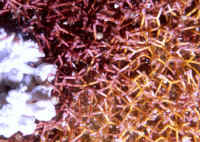 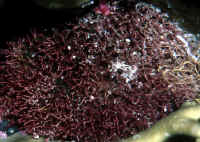
|
Bigger PIX:
The images in this table are linked to large (desktop size) copies.
Click on "framed" images to go to the larger size. |
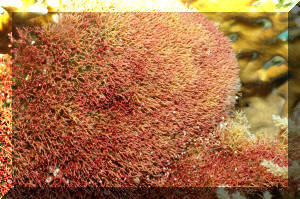 |
Genus Agalothamnion:
|
Agalothamnion herveyi, Fuzzy Bush Algae. Gelatinous in gross
appearance, fuzzy on edges up close. To 6 in. Roatan 2019.
|
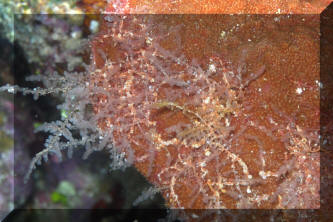
|
Genus Amphiroa:
|
Amphiroa foliacea. This one in Tobago.
|
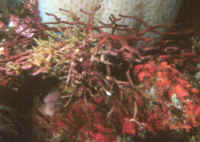
|
Bigger PIX:
The images in this table are linked
to large (desktop size) copies. Click on "framed" images
to go to the larger size. |
|
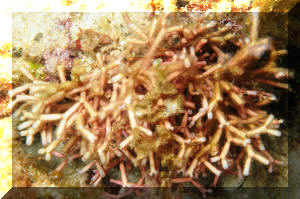
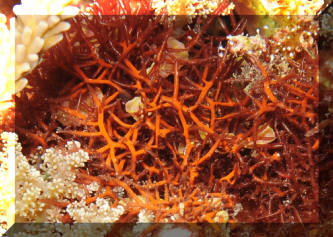
|
|
Amphiroa rigida
Thin, branched 2 in. max semi-flattened segments; pink and white in colour.
Roatan 2016 |
%20MD.JPG)
|
Bigger PIX:
The images in this table are linked
to large (desktop size) copies. Click on "framed" images
to go to the larger size. |
|
%20MD.JPG)
|
|
Amphiroa tribulus
Small clumps of flattened randomly branched flexible joints.
Whitish w/ pink highlights Here in Key Largo, FLA.
|
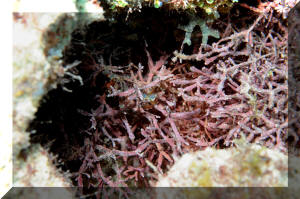
|
Bigger PIX:
The images in this table are linked
to large (desktop size) copies. Click on "framed" images
to go to the larger size. |
|
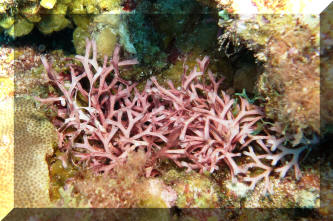
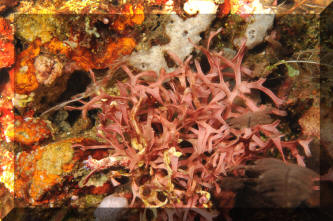
|
Genus Asgaragopsis:
|
Asparagopsis taxiformis. Creeping stolons w/
upright branches, expanding to fine branchings. To 20 cm. Widely
distributed in tropical seas. Here in Kona 2017
|
%20MD.JPG)
|
Bigger PIX:
The images in this table are linked
to large (desktop size) copies. Click on "framed" images
to go to the larger size. |
|
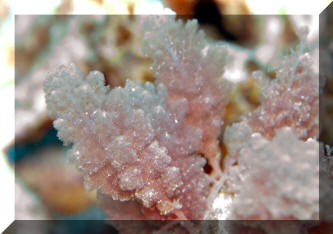
%20MD.JPG)
|
Genus Bossiella:
|
Bossiella, a common branched calcareous
genus; note wing nut shape and reproductive conceptacles (bumps
on the faces). This genus and Corallina are notably
tolerant of human pollution, often growing luxuriously near
outfall "boils".
|
|
Genus Ceramium:
|
Ceramium nitens, Striving Red Algae. To two foot
colonies. Hair-like branches in tangles; consistent red-orange in color.
Cozumel 2017.
|
%20MD.JPG)
|
Bigger PIX:
The images in this table are linked
to large (desktop size) copies. Click on "framed" images
to go to the larger size. |
|
|
Genus Coelothrix:
|
Coelothrix irregularis (Harvey) Boergesen. Bright
iridescent blue wiry turf, 2-3 cm. tall. Irregularly branched, upright.
To 10 m. Turks and Caicos 2007.
|
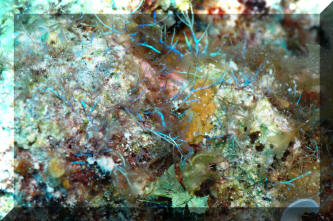
|
Genus Cryptonemia:
|
Cryptonemia crenulata, Cryptic Blade Algae. To 4 in.
max. Long, flat deep red blades that grow in clusters. Edges crenulated.
Roatan 2016
|
%20MD.JPG)
|
Genus Dasya:
| Dasya iridescens
(Schlech)
A.J.K.Millar & I.A.Abbott, 1996. Image shot at Shark Point, O'ahu, Hawai'i. |
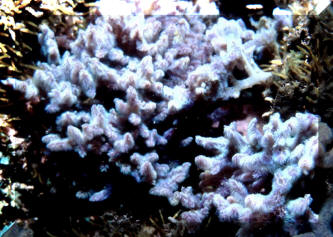
|
Genus Fauchea:
|
Fauchea sp.
Aquarium image.
|
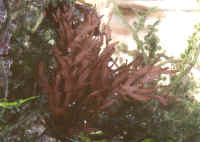
|
 |
New Print and
eBook on Amazon
Marine Aquarium Algae Control
by Robert (Bob) Fenner
|
To:
part 2, part 3,
part 4

